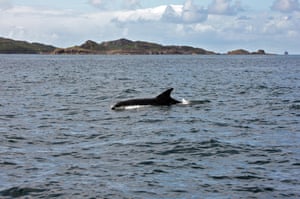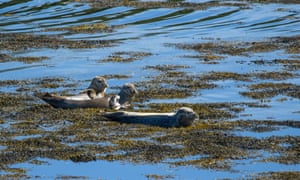Scotlands new Hebridean Whale Trail highlights places to spot the mysterious creatures and other sealife, while surrounded by some of the UKs wildest scenery

Candy-striped Eilean Glas lighthouse stands picture perfect on a rocky outcrop on the eastern tip of Scalpay island in the Outer Hebrides. The path that leads here over peaty ground feels bouncy, crossing grass left luminous by recent rain, with patchwork heather and scattered lochans reflecting a cloud-scudded sky. Wild-looking shaggy sheep graze, undeterred.
My attention though, is not focused on this enchanting landscape, but on the shimmering ocean beyond: turquoise near the shore, a deeper blue-black towards the horizon. I find a spot on the rocks and sit quietly, scanning the waves again and again for signs of life.
Im here to follow part of a new Whale Trail, an initiative launched by marine conservation charity the Hebridean Whale & Dolphin Trust (HWDT), financed by the Coastal Communities Fund. The waters of the Hebridean archipelago off Scotlands west coast are incredibly cetacean-rich; a quarter of the worlds whale and dolphin species have been recorded here. The trail highlights 33 sites that are good for land-based whale, dolphin and porpoise spotting or associated with whaling history, from Cape Wrath to the Clyde and out to St Kilda.
The idea is to raise awareness of whats out there, says trail manager Karl Stevens. Its not a tick list to rush through; we want to encourage visitors to slow down and engage with their surroundings and local communities. It may even inspire people to get involved in conservation, too.

My patience is rewarded a grey seals head pops up in the mid-distance and then, a tell-tale glistening reveals something moving close to shore. A porpoise, says Karl, as it disappears beneath the waves.
Covering everything from busy harbours to rugged headlands, endless white sand beaches and visitor centres, the trail showcases the regions coast. The spotters guide on the website tells you what to look for (dark patches, seabirds feeding, changes in water patterns and shapes of particular species). It also has tips for travelling responsibly and public transport options. The HWDT has a whale-tracking app, too, listing recent sightings, and encourages visitors to record what they see.
Im focusing on Lewis, Harris and North Uist, but my journey begins in Ullapool where I board the CalMac ferry to Stornoway. The ferry companys wildlife officer, Andy Gilbert, from marine charity ORCA, is on board and talks me through the creatures its possible to see: harbour porpoise; common, bottlenose and Rissos dolphin; minke whale; orca; humpback; basking sharks; and more. The mix of warm and cool ocean currents, variety of habitats and nutrient-rich waters suit cetaceans, and sightings are recorded year-round, though summer is best.

Of the whales, minke is most common I see them on 80% of the routes I sail over the summer, says Andy. The Minch [strait] between the mainland and islands is particularly good.
Choppy water today makes sighting challenging, but right on cue a passenger appears enthusing about a pod of 10 dolphin hes seen port-side I miss it, but theres no denying the excitement these creatures evoke.
From Stornoway, I drive north across a wide open landscape with wildflowers colouring the machair the fertile calcium-rich sand and shell plains unique to the area. Its July so still light when I arrive at the Butt of Lewis at 10.30pm. With its redbrick lighthouse, near 360-degree views and the Atlantic crashing against the cliffs, it feels like the edge of the world. Seabirds screech and theres a raw energy I can easily imagine large mysterious creatures lurking in the deep.
As the sun finally fades I head to The Decca, a nearby B&B in what was once a radio navigation station. Hosts Louise and Pete Cooper do evening meals, too (all local produce, from Stornoway smoked salmon to homemade haggis) and a six-course Hebridean tasting menu on Saturdays and even accompany dinner with a piano and Gaelic harp recital.
The next day the weathers turned. Rain and mist mean theres little visibility at Tiumpan Head Lighthouse on the Eye peninusla, one of the best spotting places in Europe, so I grab a cup of tea with the Whale and Dolphin Conservation Shorewatch volunteers (theyre always around and happy to advise novices). I saw seven species on Saturday, says Steve, including 20-plus minke whales, a humpback and fin whale You have to be patient but theyre out there.

Over on the west of Lewis I visit Gallan Head, one of the more unusual stops on the trail, where a former MOD military barracks is being transformed into a vibrant community. The Edge Cafe serves homemade food and the clifftops, with 360-degree views, make a good lookout point over the ocean.
Things brighten as I head south to Harris. Its part of the same island as Lewis, but a mountain range has kept the communities separate, and the scenery becomes increasingly dramatic. On the way to spectacular Hushinish beach (good for dolphins and porpoises) lie the ruins of Bunavoneader, the UKs last remaining whaling station, which closed in 1951.
Scalpay island, further east, is linked to Harris by a bridge visit on a Monday and the North Harris Trust runs whale and dolphin walks on the island. Part of the trails remit is to work with other charities and local communities, and there will be a programme of events for visitors to join.
My final destination is North Uist (a short ferry hop to Berneray and drive across the causeway) and RSPB reserve Balranald. Back in 1360, Scottish chronicler John of Fordun described Uist as a place where whales and other sea monsters abound, and Im hoping they still do. Outside the visitors centre are a minke and a pilot whale skull, from creatures washed up on the shore. The walk to the headland is through colourful flower-filled machair (in bloom from May to September). Its wild and windswept with vast sandy beaches and dramatic rocky stretches. The skies are alive with noisy sea birds.
I walk, I sit, I stare and repeat. Gannets divebomb into the sea, puffins skim the waters surface, oystercatchers wade on the shore. I squint as two dark shapes appear in the distance I can just make out the rhythmic rise and fall of dark backs and fins. Dolphin! I declare out loud to absolutely no one. Its not the dramatic breaching whale experience you might have on sea-based tours in places such as Canada or California, but the thrill is vivid nonetheless.
And this, I realise, is what the Whale Trail is all about. Something happens when you slow down and become absorbed in the moment. Yes, you might well see a whale, a dolphin or a porpoise … but this is real life, not a nature documentary, and you might not. This part of Scotland is a place of untamed natural beauty, which you dont need to follow the trail to appreciate. But what it does give you is a new way of looking and just knowing theyre there, going about their lives in the deep, adds a sprinkling of magic to any trip.
The trip was provided by Visit Scotland. More information on the Whale Trail at whaletrail.org. The Caledonian sleeper runs from London Euston to Inverness and Fort William from 85 one-way. CalMac operates ferries between the mainland and west coast islandsLewiss Decca B&B on Lewis has doubles from 105, thedecca.co.uk. Dunarain on Harris has doubles from 80. Brightwater B&B on Berneray has rooms from 40pp. Loganair flies from Southend to Stornoway, from about 280 return
Looking for a holiday with a difference? Browse Guardian Holidays to see a range of fantastic trips


Recent Comments